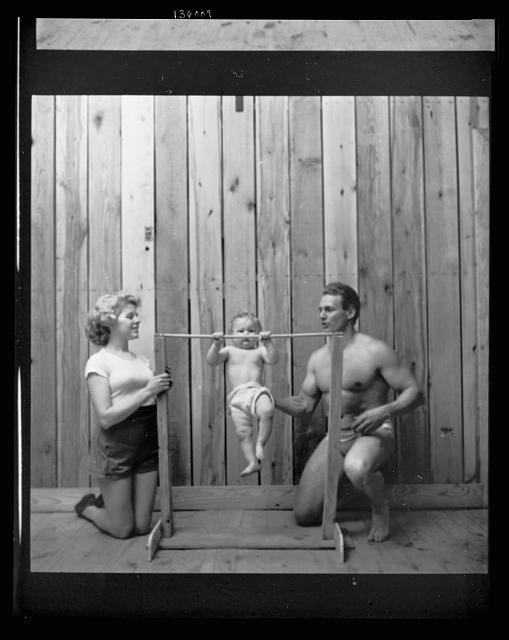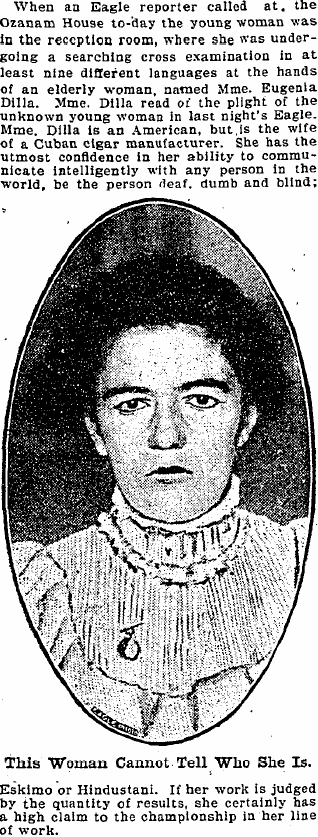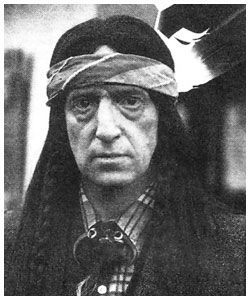Words fail us all sometimes, but what if they fail absolutely? That was the case in 1902 for a woman found in Brooklyn, who was suffering from aphasia and unable to identify herself to those who wanted to assist her. A speech expert named Mme. Eugenia Dilla was called into try to clarify matters, but it’s not clear that she was a great help. An excerpt about the locked-in, worn-out woman from the August 1 Brooklyn Daily Eagle:
“The identity of the young woman who was remanded to the Ozanam House from the Myrtle avenue police court yesterday as a vagrant is still unknown. The woman, who is suffering from aphasia, appears to be as eager as her custodians to have the mystery solved, but so far she has been wholly unable to give any definite information about herself.
When an Eagle reporter called at the Ozanam House to-day the young woman was in the reception room, where she was undergoing a searching cross examination in at least nine different languages at the hands of an elderly woman, named Mme. Eugenia Dilla. Mme. Dilla read of the plight of the unknown young woman in last night’s Eagle. Mme. Dilla is an American, but is the wife of a Cuban cigar manufacturer. She has the utmost confidence in her ability to communicate intelligently with any person in the world, be the person deaf, dumb and blind, Eskimo or Hindustani. If her work is judged by the quantity of results, she certainly has a high claim to the championship in her line of work. Mme. Dilla talks with her mouth, with her eyes, with her arms, with her shoulders and with her hands. With her hands she speaks first the universal sign language, and beside this, she speaks deaf mute in English, French, Spanish, German and many more tongues, or rather, hands.
When the unknown woman had been put through her inquisition to-day Mme. Dilla stated with absolute assurance that the woman’s name was Favorita, Eurica, Juanita Frederica, Jacinta Irenita Futurita. This was her first name. Her last, or family, name was Farina Irena Jacinita.
‘Do you think she has a middle name?’ the expert communicator was asked.

"Etta betta buega eeny meeny ming no? Ya?"
Mme. Dilla renewed the attack with face, arms, hands, voice and eyes. What she did with her face and eyes and arms cannot be described. What she said sounded like:
‘Etta betta buega eeny meeny ming no? Ya?’
The unfortunate woman bowed and smiled in a mystified way and Mme. Dilla said, with triumph in her voice:
‘Oh, yes, she understands. She says I’m her friend and I’m the only one who understands her. Her middle name? Oh, yes,’ and then addressing the lost woman:
”Looka syta moya numo?’ and other similar things.
‘She says her middle name is Florencita,’ announced Mme. Dilla.
The superintendent of the home, referring to Mme. Dilla, said in a whisper to the Eagle reporter:
‘I think she’s too fussy.’
Mme. Dilla overheard the remark and said with dignity: ‘I assure you that I can find out all that any one can. This woman should be returned to friends. She is lost and she says I am the only friend she has. I insist on finding out all about her.’

"She tooted like a steamboat."
Some one suggested that the madame might obtain fine results with a deck of cards. The madame scorned the idea and continued her sextuple language of signs, passes, spoken and written words and symbols. All that she did and said cannot be reproduced or even indicated. She made noises like all kinds of guns and cannons. She tooted like a steamboat. She turned imaginary keys and broke imaginary windows. She rang imaginary bells and she fell over as if shot. The young woman looked on with wonder depicted in every feature. At last she apparently decided that the madame was trying to amuse her and she smiled and nodded and once or twice clapped her hands. Mme. Dilla kept up her attack for an hour. Then she announced that she had learned the story of the woman’s life. This is the story as told by Mme. Dilla:
‘She is 30 years old and has been married, but her husband is dead. She was born in the Western part of Cuba and suffered much from the Spanish oppression during the war. One of her ancestors was a Chinaman, a very common thing in Cuba. At the time of war she was rich and happy, but lost everything and joined the reconcentrados. She witnessed the death of her husband, who was shot down before her eyes. The shock was so great that she was completely prostrated, and has never recovered the power of speech. She came to this country on a boat and took a furnished room on the wharf. She came to find her brother, who has been in New York for several years. She got into a crooked house of some sort. They took from her everything she had and turned her adrift in the street.’
The superintendent of the Ozanam House did not appear to have much confidence in this story.”





















